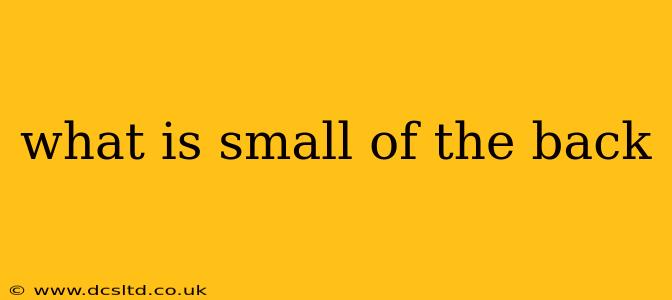The "small of the back" is a colloquial term referring to the lumbar region of the spine. This is the lower part of your back, located between the rib cage and the pelvis. It's often considered the area where the back curves inward, creating the natural "s" shape of the spine. Understanding the anatomy and potential issues related to this area is crucial for maintaining good back health.
What are the structures in the small of the back?
The small of the back houses several crucial structures:
- Lumbar Vertebrae: Five individual bones (L1-L5) that stack on top of each other to form the lumbar spine. These vertebrae are larger and stronger than those in the thoracic (upper back) or cervical (neck) regions, designed to bear more weight.
- Intervertebral Discs: These are cushions of cartilage situated between each vertebra. They act as shock absorbers, allowing for flexibility and movement. Herniated or bulging discs in this area are a common source of lower back pain.
- Spinal Cord and Nerves: The spinal cord runs through the vertebral canal, protected by the vertebrae. Nerves branch off from the spinal cord at each vertebral level, innervating the legs, pelvis, and abdomen. Compressed nerves in the lumbar region can cause pain, numbness, or weakness in the legs (sciatica).
- Muscles: Many muscles support and move the lumbar spine. These include the erector spinae muscles (responsible for extending the back), quadratus lumborum (involved in lateral bending), and abdominal muscles (essential for core stability). Weak or strained muscles in this area can contribute to back pain.
- Ligaments: These strong connective tissues connect the vertebrae and provide stability to the spine.
What causes pain in the small of the back?
Pain in the small of the back, often referred to as lower back pain, is a very common complaint. Several factors can contribute to this:
- Muscle Strains and Sprains: Overexertion, improper lifting techniques, or sudden movements can lead to muscle strains or sprains.
- Herniated or Bulging Discs: The inner gel-like substance of a disc can bulge or rupture, putting pressure on nearby nerves.
- Spinal Stenosis: Narrowing of the spinal canal puts pressure on the nerves.
- Degenerative Disc Disease: Age-related wear and tear on the intervertebral discs.
- Spondylolisthesis: A vertebra slips forward over the one below it.
- Osteoarthritis: Degeneration of the cartilage in the facet joints (small joints between the vertebrae).
- Poor Posture: Maintaining poor posture puts extra strain on the lumbar spine.
- Obesity: Excess weight increases the load on the lower back.
- Infections: Rarely, infections can affect the vertebrae or discs.
How is pain in the small of the back treated?
Treatment for lower back pain depends on the underlying cause and severity. Options may include:
- Rest and Ice/Heat: Resting the back and applying ice or heat can help reduce inflammation and pain.
- Over-the-Counter Pain Relievers: Medications like ibuprofen or acetaminophen can help manage pain.
- Physical Therapy: Exercises to strengthen core muscles, improve posture, and increase flexibility.
- Chiropractic Care: Manual adjustments to improve spinal alignment.
- Injections: Corticosteroid injections can reduce inflammation.
- Surgery: In severe cases, surgery may be necessary to address conditions like herniated discs or spinal stenosis.
What are some ways to prevent pain in the small of the back?
Preventing pain in the small of the back involves adopting healthy habits:
- Maintain good posture: Stand tall, avoid slouching, and use proper lifting techniques.
- Strengthen core muscles: Regular exercise, including core strengthening exercises, is crucial.
- Maintain a healthy weight: Excess weight puts extra strain on the lower back.
- Use ergonomic furniture: Ensure your workstation is ergonomically designed to support your back.
- Stretch regularly: Regular stretching helps maintain flexibility and prevent muscle stiffness.
This information is intended for general knowledge and informational purposes only, and does not constitute medical advice. It is essential to consult with a healthcare professional for any concerns about pain in the small of the back or any other medical condition. They can provide a proper diagnosis and recommend the appropriate treatment plan.
